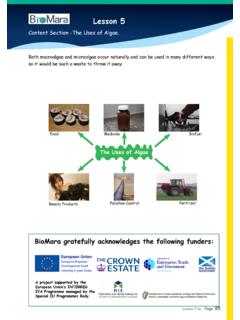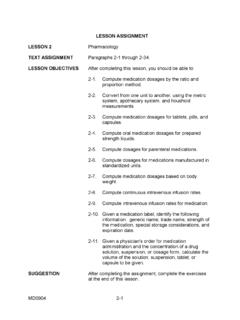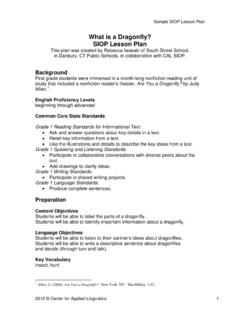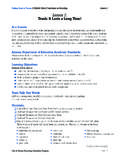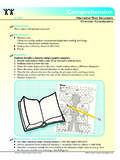Transcription of Lesson 1 - BioMara
1 Lesson 1 Content Section - What is Algae? A project supported by the European Union s INTERREG IVA Programme managed by the Special EU Programmes gratefully acknowledges the following funders:Plants and SeaweedFlowerLeafStemRootsBladeAir BladderStipeRockHoldfastMidribThallus FrondAlgae are organisms that are like plants and vegetables. They are commonlyfound living in the sea, rivers, lakes or ponds. All algae make energy from the sun. There are two different types of algae and they are called Macroalgae and Microal-gae .Macroalgae are commonly known as seaweed . The word macro means big so you can think of a big plant that lives in the sea. Microalgae are often called phyto-plankton.
2 The word micro means very small so you can think of a small plant that lives in the sea, rivers, ponds or lakes. They are so small that you will be unable to see them in the water with your eyes. They are normally viewed under a (Seaweed) is a multicellular organism. This means that they contain many cells that let the macroalgae func-tion. The main parts of the macroalgae are the holdfast , the blade , the frond , the stipe , the thallus , the mid-rib and the air-bladders . The holdfast has an appearance similar to the roots of plants but it does not provide any nutrients to the macroalgae. Nutrients are absorbed by the entire macroalga from the water. The holdfast provides support to the macroalga.
3 The blade is like the leaf of a tree and the stipe is like the stem of a flower, if present. This is Algeena who will be giving us information on is Mike who will be giving us information on One. Page 1 Lesson One. Page 2 The stipe transports nutrients to the hold-fast. A collection of blades is known as a frond. The body of the macroalgae is known as the thallus. Some macroalgae have air-bladders to help them float. The air-bladders contain gas and help lift the macroalgae to the surface so that the organisms can get sunlight. Other macroalgae that do not have air-bladders have long stipes to help them float to the sur-face. Some macroalgae have a mid-rib which are located in the centre of the are divided by their colour into brown, green and red macroalgae.
4 The colour of the macroalgae are due to the different pigments within the organisms. There are brown, green and red pigments within the various macroalgae. All macroal-gae have green pigments so they can make energy from the is another type of marine alga. It has a red colour and forms a tough crust. Maerl is small in size and you could hold it in your hand. Unlike other macroalgae they are not attached by a holdfast but live on the sea bed with the sand. Microalgae are small floating organisms that contain one cell and so are called unicellular organisms. The cell is sur-rounded by a cell wall. Microalgae can make their own energy and store their energy in the cell. Microalgae are different in their size, shape and colour.
5 They are very small in size, usually one quarter of a colour of the microalgae cell depends on their pigments. They can either appear blue-green, yellow, brown or two main types of microalgae are Diatoms and Dinoflagellates .Diatoms are a type of microalgae. They have different shapes. Some are shaped like spheres, elliptical (shaped like a rugby ball), triangles and other diatoms may be shaped like a stars. They contain tiny amounts of oil within their cell. The oil helps them move within the water to find their food and nutrients. They are weak swimmers so the water currents help them to move. A diatom cell is surrounded by a silica shell which makes the cell wall. The silica looks like glass and is used to protect the cells.
6 The cell wall within the diatom is like a box with an overlapping lid. They cannot move themselves so they float second type of microalgae are called dinoflagellates. Most dinoflagellates have two flagella which appear like short tails that help them move through the water. One flagellum is wrapped around the cell and the other is visible and helps the microalgae move. They can also use the oil within their cell to sink or are surrounded by a tough shell which they use for types ofdinoflagellates glow in the dark at night when disturbed. Diatoms and dinoflagellates grow very quickly and large amounts are called algal blooms can cause problems for the environment. Both of these microalgae have the ability to cause food poisoning.
7 Shell-fish may eat the microalgae as their food and if humans then eat the shellfish they may get sick. Some algal blooms are very beneficial to the environment making huge amounts of food for One. Page 3 Brief Summary Aim: The overall aim of this Lesson is to introduce algae and distinguish between the different types of are divided into macroalgae which are commonly known as seaweed and microalgae which are sometimes known as phytoplankton. Both macroalgae and microalgae produce oxygen. Marcoalgae are large algae and they look like plants. They are multicel-lular as they contain many cells. They contain a holdfast which can be at-tached to sand, boats or rocks. They contain a stipe similar to a stem of plants.
8 They contain blades similar to leaves of a plant and a collection of blades are called fronds . Some macroalgae have air-bladders this helps them float to the surface to catch the sun. Other macroalgae have no air-bladders just long flexible are divided into brown, green and red macroalgae. The different colours are due to the pigments brown, green and red pigments within the macroalgae. There is another type of marine alga which is called Maerl . These are very small and are unattached to rocks so they live on the sea bed. They have a hard calcium crust and are red or brown in colour. Whenever they die they lose their colour and turn are much smaller organisms. They can only be seen under a microscope.
9 They are unicellular which means they have only one cell. They are like floating plants and they are unattached. There are two common types of microalgae. Diatoms are one variety and they have oil within their bodies. This helps them to float. Dinoflagelletes are another variety of microalgae which have flagella . The flagella help the dinoflagellates to swim. Certain varieties of dinoflagellates glow in the dark at night when Section Lesson 1 What is Algae? Lesson One. Page 4 Learning Outcomes: Explain briefly what algae is and to describe the structure of macroalgae and flower. Describe the difference between algae and flower. Describe the two different varieties of algae by providing details about the colours of macroalgae and the two different varieties of :Recall the structure of plants/ flowers.
10 (Use an example of a real plant or flower).Teacher will explain by the use of an image the difference between macroalgae (seaweed) and microalgae (phytoplankton).Pupils will observe that macroalgae and microalgae have different pupils may discuss in their own words features of macroalgae (seaweed) and :Activity 1- Label the different parts of macroalgae (seaweeds) and a 2. Select the key words in the box associated with macroalgae, microalgae and 3. Show the different varieties of macroalgae and 4. CrosswordActivity 5. Compare the length of different varieties of macroalgae. Draw a graph of the different lengths. Teacher will test the knowledge of pupils by getting them draw their own dia-gram of a flower and macroalgae and label it.

